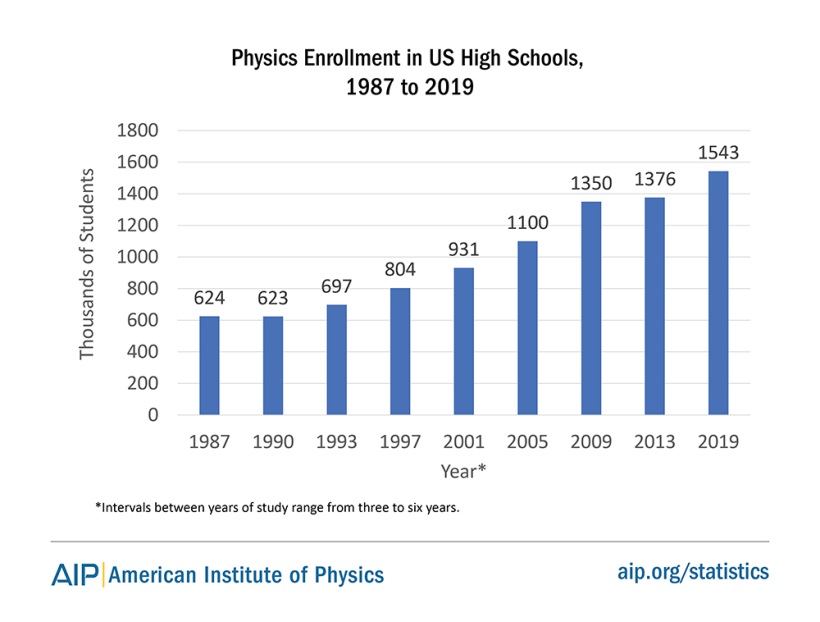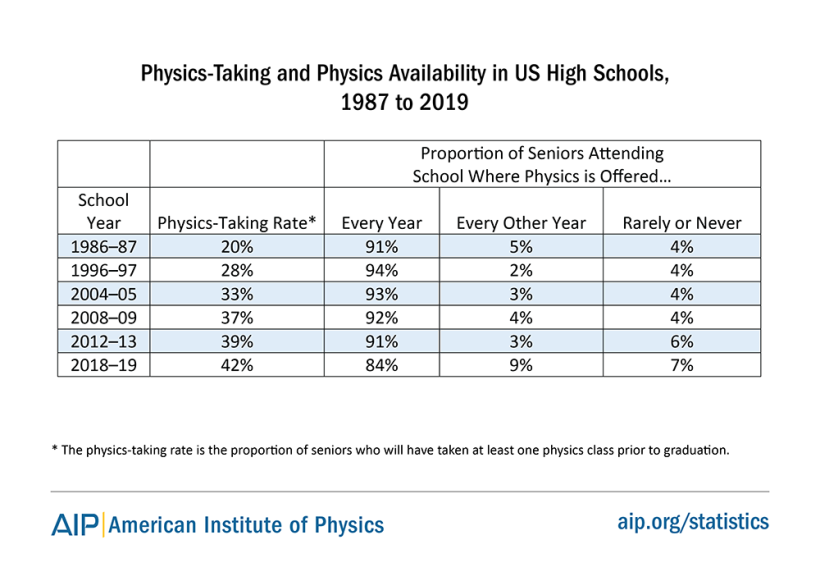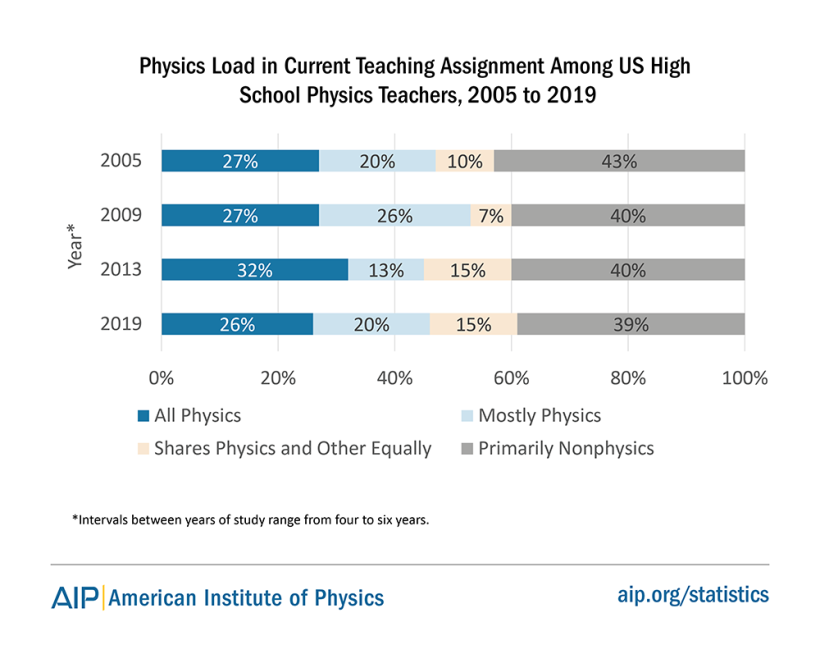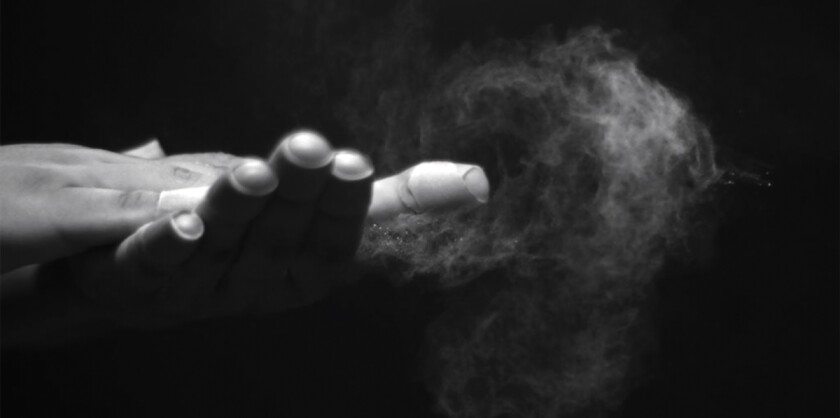High School Physics Overview
This overview is the first report from the 2018-19 National Survey of High School Physics Teachers. The number of students taking high school physics in the US has reached over 1.5 million. High school teachers teaching physics is up to 27,600. Although 93% of seniors in the US attend high schools where physics is offered at least every other year, the percentage of seniors at schools where physics is offered annually dropped to 84%. A handful of states continue their trends of physics availability to their high school seniors.
US high school physics enrollment increased 12% since the previous survey was conducted in 2013, outpacing the 6%1 growth of high school seniors. The number of teachers teaching at least one physics class remained virtually unchanged during the same time period. AP Physics 1 was developed to be a first-year physics course, and the new course appears to be contributing to the increase in student enrollment in physics and the physics taking rate.
Figure 1

- The number of students taking high school physics rose 12%, from 1,376,000 to 1,543,000, since the previous survey in 2013 (Figure 1).
Table 1

- The number of high school students in their first year of physics also rose about 13% to 1,406,000 during the six-year period 2013-19. This number can also be interpreted as the number of graduates who will have taken at least one high school physics course. The proportion of high school graduates who will have taken at least one high school physics course, referred to as the physics-taking rate, rose to 42% from 39% in 2013 (Table 1).
- Since schools with more seniors enrolled are more likely to offer physics, we do not use the proportion of schools offering physics. Instead, we use the proportion of seniors attending schools where physics is offered annually, offered regularly (meaning every other year), or offered rarely. Note that simply offering physics at the schools these students attend does not guarantee that the schools could make physics available to every senior should they decide to enroll.
- The proportion of seniors attending schools where physics is offered regularly remained relatively stable at 93%. The percentage of seniors attending schools that do not offer physics at all increased slightly to 7% from 6% in 2013.
- One of the most important changes found in the 2019 study is the drop in the national proportion of seniors attending schools where physics is offered annually to 84% after many years at 91% or higher. In addition, about 9% of seniors attend schools that offer physics in alternate years, which is an unprecedented increase from 3% in 2013 and 2% to 5% in previous surveys.
- The recent introduction of AP Physics 1, which has no prerequisite, likely contributes toward the increased enrollment among year-one physics students. AP Physics B and AP Physics C were both intended to be second-year courses. However, we know that most of the students in AP Physics B and some of the students in AP Physics C were in their first physics courses.
Figure 2

- The number of high school teachers teaching physics remained virtually unchanged, shifting from 27,0002 to 27,600 since 2013.
- The proportion of teachers who teach all or mostly physics, 46%, also remained virtually unchanged from 45% in 2013, but below the recent high of 53% in 2009 (Figure 2).
Table 2

- Nine states account for half of the high school seniors in the United States (Table 2). Seven states account for half of the students taking at least one high school physics course. Five states are common to both lists. Compared to the high school seniors by states, Texas high school students are overrepresented in physics and Florida high school students are underrepresented in physics.
Figure 3

Figure 4

Table 3

- In Table 3, we provide the list of states in which physics is offered regularly at schools with higher-than-average rates and those with lower-than-average rates in both 2013 and 2019. In 2019, 93% of seniors attended a school where physics is offered regularly.
Table 4

- In Table 4, we provide a list of states in which physics is offered annually at schools with higher and lower rates of participation by seniors in 2013 and 2019. The national average in 2019 was 84%.
Survey Methodology
This study is based on a sample of one-sixth of the public and private high schools classified as regular, technical, or emphasis schools in the United States. Data collection for this round began in the fall of 2018.
We define a high school as a school with at least three students enrolled in grade 12. Many of these are traditional high schools; some comprise grades 7–12, and others, grades K–12.
We began with web searches for each of the 3,751 high schools in our sample. If we could identify a physics teacher at the school, we collected the contact information for that teacher. If not, we collected contact information for the principal or science chair. We then contacted each of the schools where we had not identified a physics teacher by phone and email to determine whether physics was offered at the school and, if so, who taught it. We collected data on whether physics was offered from 3,371 of our 3,751 (90%) sampled schools. We compared demographics for the non-responding schools with those of the responding schools and found no evidence to suggest that the two groups differ significantly. Therefore, evidence suggests that we have a representative sample of schools.
During the spring of 2019, we contacted each of the 3,538 teachers we had identified in the fall to learn more about physics in each of the high schools. We heard back from 42% of the teachers.
This survey series has exclusively focused on physics courses taught in high schools. In some cases, students at one school might attend a physics class at another school synchronously or asynchronously via video. When this was reported by the school, we counted these students as being enrolled in a physics class. This is consistent with our practice in previous studies. Due to the COVID-19 pandemic, which started after we collected these data, the SRC will collect data on wholly online physics classes in future surveys.
References
[1] See Digest of Education Statistics, NCES (2018) https://nces.ed.gov/programs/digest/d18/tables/dt18_219.10.asp
[2] See “Focus On Who Teaches High School Physics,” AIP (December 2014) https://www.aip.org/sites/default/files/statistics/highschool/hs-whotea…
Acknowledgements
We offer our sincere gratitude to the responding principals, teachers, and staff at our sampled schools for helping us provide this information.
e-Updates
You can sign up to receive email alerts that notify you when we post a new report or resource. Visit https://www.aip.org/statistics/stats_subscribe
Follow Us on Twitter
The Statistical Research Center is your source for data on education, careers, and diversity in physics, astronomy, and other physical sciences. Follow us at @AIP_Stats.
High School Physics Overview
By Raymond Y. Chu and Susan White
Published: May 2021
A product of the Statistical Research Center of the American Institute of Physics
1 Physics Ellipse, College Park, MD 20740
stats@aip.org






